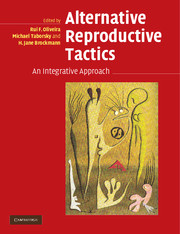Book contents
- Frontmatter
- Contents
- List of contributors
- Preface
- 1 The evolution of alternative reproductive tactics: concepts and questions
- PART I ULTIMATE CAUSES AND ORIGINS OF ALTERNATIVE REPRODUCTIVE TACTICS
- PART II PROXIMATE MECHANISMS OF ALTERNATIVE REPRODUCTIVE TACTICS
- 5 The roles of genes and the environment in the expression and evolution of alternative tactics
- 6 Neuroendocrine mechanisms of alternative reproductive tactics: the chemical language of reproductive and social plasticity
- 7 Hormones and alternative reproductive tactics in vertebrates
- PART III TAXONOMIC REVIEWS OF ALTERNATIVE REPRODUCTIVE TACTICS
- PART IV EMERGING PERSPECTIVES ON ALTERNATIVE REPRODUCTIVE TACTICS
- Index of species
- Subject index
- References
7 - Hormones and alternative reproductive tactics in vertebrates
Published online by Cambridge University Press: 10 August 2009
- Frontmatter
- Contents
- List of contributors
- Preface
- 1 The evolution of alternative reproductive tactics: concepts and questions
- PART I ULTIMATE CAUSES AND ORIGINS OF ALTERNATIVE REPRODUCTIVE TACTICS
- PART II PROXIMATE MECHANISMS OF ALTERNATIVE REPRODUCTIVE TACTICS
- 5 The roles of genes and the environment in the expression and evolution of alternative tactics
- 6 Neuroendocrine mechanisms of alternative reproductive tactics: the chemical language of reproductive and social plasticity
- 7 Hormones and alternative reproductive tactics in vertebrates
- PART III TAXONOMIC REVIEWS OF ALTERNATIVE REPRODUCTIVE TACTICS
- PART IV EMERGING PERSPECTIVES ON ALTERNATIVE REPRODUCTIVE TACTICS
- Index of species
- Subject index
- References
Summary
CHAPTER SUMMARY
The wide diversity of alternative tactics of reproduction found among vertebrates offers a unique opportunity to study the endocrine mechanisms underlying the phenotypic variation of reproductive traits. Here, we first assess the existing conceptual frameworks on the mechanisms underlying the expression of alternative reproductive tactics (ARTs) by reviewing the available data on hormone levels in alternative phenotypes and on the effects of hormone manipulations in different vertebrate taxa. We then highlight recent studies that have opened new avenues of research on the neuroendocrine basis of ARTs, such as the use of functional genomics to study differential gene expression between morphs. Finally, we stress the need to integrate the study of ARTs with the mechanisms underlying the expression of alternative phenotypes and with functional studies of ARTs. Only such an integrative approach will allow a comprehensive understanding of the evolution and development of ARTs.
INTRODUCTION
Setting the scene
According to the classic paradigm of the endocrine control of vertebrate reproduction, the hypothalamus–pituitary–gonadal (HPG) axis controls gonadal maturation, the expression of secondary sexual characters, and reproductive behavior (Figure 7.1A). However, in some species there are males in which gonadal maturation and sperm production are dissociated from the expression of behavioral and morphological male traits (i.e., secondary sexual characters). They are males with male alternative reproductive tactics (ARTs), and they offer unique opportunities to study the proximate mechanisms of reproduction (Figure 7.1B).
- Type
- Chapter
- Information
- Alternative Reproductive TacticsAn Integrative Approach, pp. 132 - 174Publisher: Cambridge University PressPrint publication year: 2008
References
- 22
- Cited by



